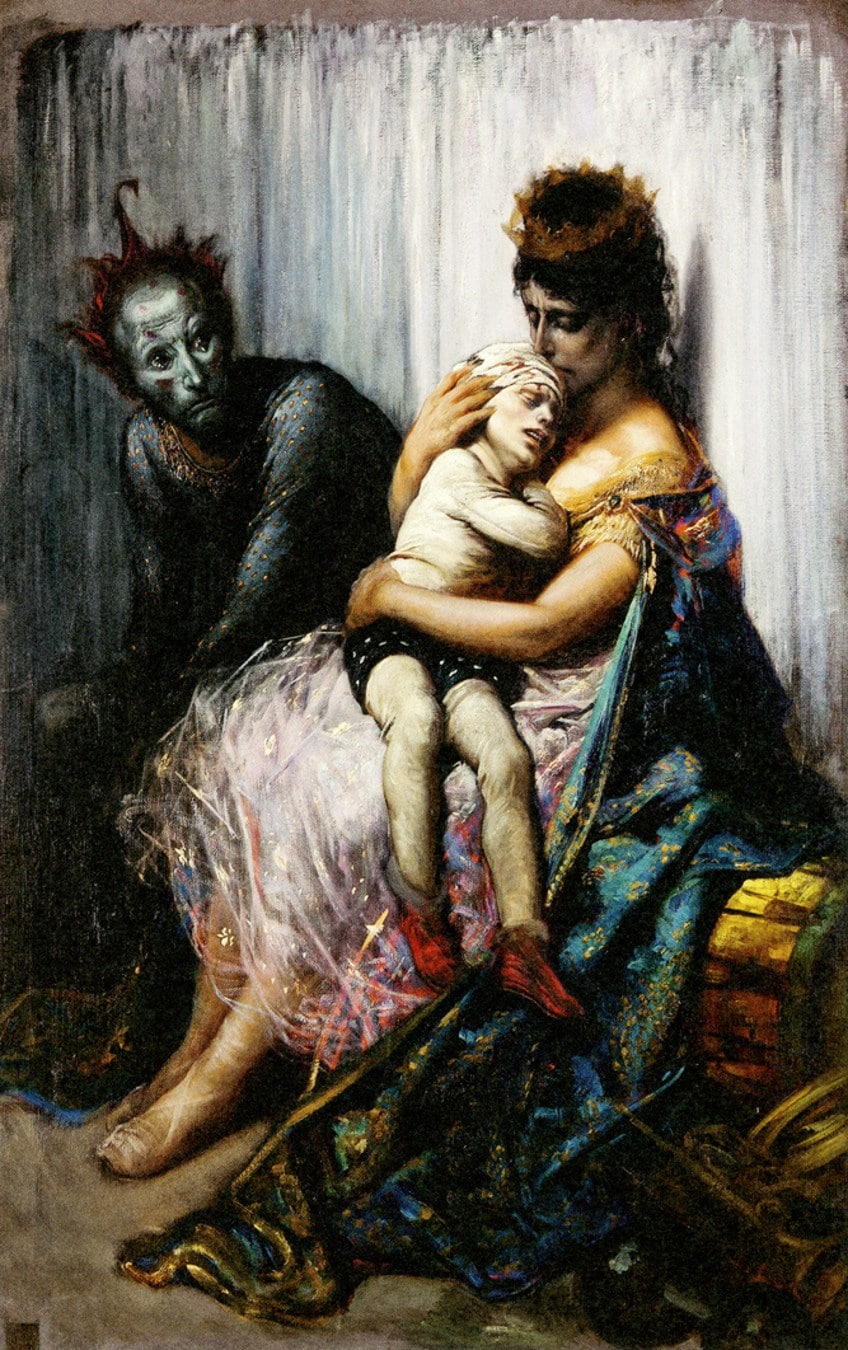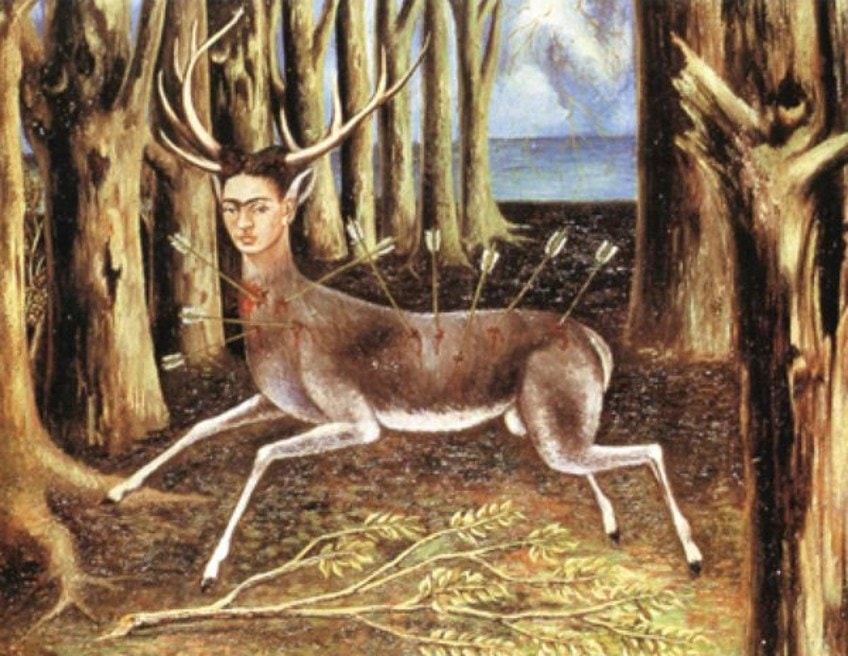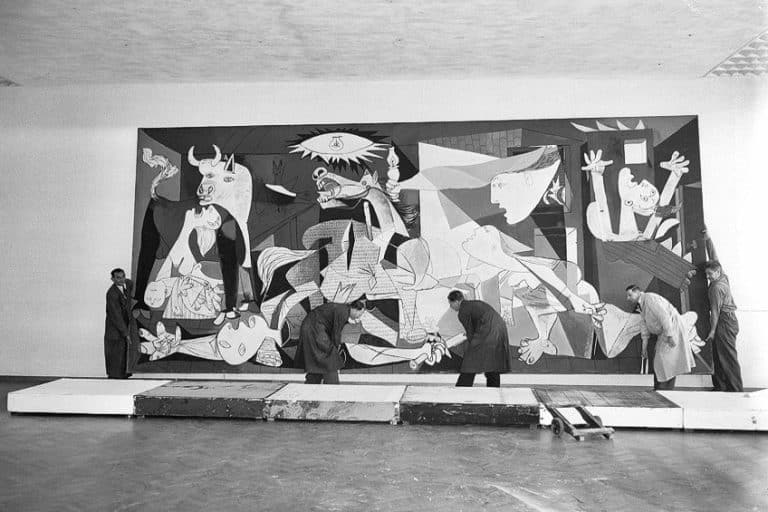Famous Sad Paintings – The World’s Most Emotional Artworks
Of the broad spectrum of human emotions, sadness is the one emotion that has been a common underlying element of many famous artworks to date. The exploration of the melancholic condition and the different life events that stir this emotion has been captured beautifully by artists of all ages. This article will explore some of the most famous sad paintings in art history and why they have left such a lasting impression.
Table of Contents
- 1 The Top 10 Most Famous Sad Paintings of All Time
- 1.1 La Mélancolie (c. 1785) by Louis-Jean-François Lagrenée
- 1.2 The Sad Message (1838) by Peter Fendi
- 1.3 La Douleur (Sorrow) (1868 – 1869) by Paul Cézanne
- 1.4 Inconsolable Grief (1884) by Ivan Kramskoi
- 1.5 At Eternity’s Gate (1890) by Vincent van Gogh
- 1.6 Melancholy (c. 1892) by Edvard Munch
- 1.7 Femme Assise (c. 1902 – 1903) by Pablo Picasso
- 1.8 The Old Guitarist (1903 – 1904) by Pablo Picasso
- 1.9 The Wounded Deer (1946) by Frida Kahlo
- 1.10 Christina’s World (1948) by Andrew Wyeth
- 2 Frequently Asked Questions
The Top 10 Most Famous Sad Paintings of All Time
Sadness in art has been a popular subject for many famous artists throughout art history and has been known to be an emotion shared and represented by all great artists from the Renaissance up until the 21st century.
Depicting human emotion was not always at the forefront of art and only rose to popularity after the emergence of the art movement Expressionism.
This was followed by many artists both before and in between the movement who chose to prioritize the depiction of the everyday citizen. Below, we will explore the top 10 most famous sad paintings of all time, which are sure to pull on your heartstrings.

La Mélancolie (c. 1785) by Louis-Jean-François Lagrenée
| Artist Name | Louis-Jean-François Lagrenée (1725 – 1805) |
| Date | c. 1785 |
| Medium | Oil on canvas |
| Dimensions (cm) | 50 x 72 |
| Where It Is Housed | Musée du Louvre, Paris, France |
La Mélancolie is one of the most emotional artworks from the 18th century that still bears weight on the subject of melancholy and sadness in art. Created in 1785 by Louis-Jean-François Lagrenée, La Mélancolie is a popular sad painting, which represents the trending style of the time, Rococo.
This painting style involved depicting scenes with incredible details and was more focused on décor.
La Mélancolie is a simple yet impactful demonstration of its title and portrays a young woman adorned in a soft, flowing garment with her head resting on her arm supported by her thigh. This is a classical representation of melancholy, which is familiar to all who encounter it. The woman’s body language speaks volumes and is highlighted by the dark background of the painting and her laser-eyed gaze as she stares into, what can be assumed to be, mental oblivion.

The Sad Message (1838) by Peter Fendi
| Artist Name | Peter Fendi (1796 – 1842) |
| Date | 1838 |
| Medium | Oil on canvas |
| Dimensions (cm) | 36.5 x 29.5 |
| Where It Is Housed | Vienna Museum, Vienna, Austria |
Peter Fendi was a famous Austrian painter associated with the Biedermeier period in art, which enabled access to the fine arts to the broader public, specifically middle-class citizens. During this period, scenes of everyday life became an increasingly popular subject for many artists to include in their agenda and included emotional experiences of sadness and the “bluer” feelings of human society.
This piece is one of the most famous sad paintings since it served as a breakthrough in genre painting.
The Sad Message portrays a woman with a baby and child standing beside her. The sadness evoked by the painting is seen in the fallen letter on her lap and the soldier who appears to return a few items to her. One can conclude that the woman has just received the worst news of her husband’s death and her sadness becomes heightened by the presence of her two young children, who are now without a father.

La Douleur (Sorrow) (1868 – 1869) by Paul Cézanne
| Artist Name | Paul Cézanne (1839 – 1906) |
| Date | 1868 – 1869 |
| Medium | Oil on canvas |
| Dimensions (cm) | 160 x 120 |
| Where It Is Housed | Musée d’Orsay, Paris |
La Douleur, also known as Sorrow or The Magdalen, is a 19th-century painting by Paul Cézanne that depicts the religious figure of Mary Magdalene from the New Testament of the bible. Created between 1868 and 1869, La Douleur has since become one of the most famous depictions of sadness in art for its depiction of Mary Magdalene shortly after the news of Jesus Christ’s crucifixion. One can relate to the grief associated with the loss of a loved one, especially the impending news of certain death, which makes this painting one of the most emotional artworks to date.
Cézanne often painted subjects with religious themes and was a key figure in the 19th-century Impressionist movement.

Inconsolable Grief (1884) by Ivan Kramskoi
| Artist Name | Ivan Nikolaevich Kramskoi (1837 – 1887) |
| Date | 1884 |
| Medium | Oil on canvas |
| Dimensions (cm) | 228 x 141 |
| Where It Is Housed | Tretyakov Gallery, Moscow |
Inconsolable Grief is an 1884 oil painting by Ivan Nikolaevich Kramskoi, one of Russia’s leading painters and art critics of the Realism era. Kramskoi also received his fair share of criticism for being one of the most controversial painters and was even criticized for adopting humanist ideals to depict religious subjects and figures with complex psychological and moral narratives.
The painting reflects the grief that Kramskoi experienced firsthand due to the loss of his two young children within four years. Surrounded by grief, Kramskoi captured his experience by painting his wife as the subject of the painting, with her handkerchief pressed against her face as she grieves. Her eyes appear exhausted and dark, hinting at the nature of a restless parent who has just lost her children and is still in disbelief.
The imagery of this sad painting truly tugs at the heartstrings of those who have experienced such a loss.

At Eternity’s Gate (1890) by Vincent van Gogh
| Artist Name | Vincent Willem van Gogh (1853 – 1890) |
| Date | 1890 |
| Medium | Oil on canvas |
| Dimensions (cm) | 80 x 64 |
| Where It Is Housed | Kröller-Müller Museum, Otterlo, Netherlands |
Vincent van Gogh was one of the few artists of the 19th century with the ability to translate sadness and melancholia into emotional artworks that traverse the depth of such emotion, relatable to many today. At Eternity’s Gate is one of Van Gogh’s most emotional paintings, which demonstrates a deep understanding of emotion through the physical reaction of the subject. The painting portrays an old man seated in a chair with his hands on his head, weeping at the thought of his life coming to an end.
The painting is an accurate depiction of the emotional struggle of grappling with the difficult news of death and captures the physical expression of grief.

Melancholy (c. 1892) by Edvard Munch
| Artist Name | Edvard Munch (1863 – 1944) |
| Date | c. 1892 |
| Medium | Oil on canvas |
| Dimensions (cm) | 96 x 64 |
| Where It Is Housed | Private collection |
Melancholy serves as the manifestation of the title itself illustrated by the depiction of a woman who appears struck with depression. The painting was first prepared as a pastel drawing in 1891 and has since been recreated several times.
Edvard Munch was also an incredibly famous painter under the Expressionist movement who was familiar with channeling strong emotions such as anger, grief, sorrow, and anxiety into paintings.
Munch’s paintings do not merely evoke the emotion itself but they also stimulate a sympathetic reaction. Coupled with his signature wavy brushstroke style and application of color, Munch knew exactly how to represent such a complex emotion through space, body language, and color.

The painting was also titled Jappe on the Beach since the subject was identified as Munch’s close friend Jappe Nielssen, who was experiencing the unhappy effects of a romantic affair and became the subject of Munch’s exploration of the melancholic man.
Another interesting fact about Munch was that he received much of his inspiration for art from the Polish author Stanislaw Przybyszewski during his studies in Poland.
In fact, it was Przybyszewski’s book, Mass for the Dead (year unknown), that drew the artist in, and many of Munch’s works reflect this. Przybyszewski also acted as a model for Munch between the years 1893 and 1898.
Femme Assise (c. 1902 – 1903) by Pablo Picasso
| Artist Name | Pablo Ruiz Picasso (1881 – 1973) |
| Date | 1902 – 1903 |
| Medium | Oil on canvas |
| Dimensions (cm) | 99 x 68.5 |
| Where It Is Housed | The Detroit Museum of Art, Michigan |
Spanish artist Pablo Picasso is one of the most well-known artists of the 20th century who created famous sad artwork between 1902 and1903. His unique approach to artmaking is what made his work stand out from many painters who came before and he was soon recognized as a leader in Cubism.
Femme Assise is one such painting that is not only one of the most famous sad paintings in the world, but it is also a reflection of the artist’s inner world and battle with depression, trauma, and grief. The painting portrays a melancholic woman who appears to slump downward and rest on her arm in a defeated manner. She also appears emotionally detached and distant as she stares at the wall of a cell.
Picasso uses deep blue hues to evoke the feeling of melancholy and isolation across the canvas.
While in Barcelona around 1902, Picasso sketched many images of prostitutes from the women’s prison at St. Lazare and was haunted by these scenes due to the suicide of a close friend. This period of painting was called Picasso’s blue period since he included various rich shades of blue in his works, which were important to the Symbolist movement at the time. It is believed that the melancholic woman in the painting was the mistress of Picasso’s late friend and someone to whom Picasso was also attracted.
The color blue was commonly associated with evil, night time, and death, so it was a fitting choice for the somber mood. The double layer of symbolism in the painting points to the mistress becoming a prisoner of her grief.
The Old Guitarist (1903 – 1904) by Pablo Picasso
| Artist Name | Pablo Ruiz Picasso (1881 – 1973) |
| Date | 1903 – 1904 |
| Medium | Oil on canvas |
| Dimensions (cm) | 122.9 × 82.6 |
| Where It Is Housed | Art Institute of Chicago, Chicago, Illinois |
The Old Guitarist was painted during Picasso’s blue period and is one of the most iconic sad paintings of all time. The painting evokes the themes of misery, suffering, and melancholy, which are further emphasized by Picasso’s use of the color blue and the figure playing the guitar in a defeated manner.
The figure is believed to be a blind musician and reflects Picasso’s struggle with sympathy for the suffering of the downtrodden.
Picasso faced his battles with poverty and faced financial bad luck throughout 1902. Following the death of his close friend, Carlos Casagema, this period only heightened the artist’s experience of sadness and thus resulted in monochromatic blue paintings as found in Picasso’s “Blue Period”.
The Wounded Deer (1946) by Frida Kahlo
| Artist Name | Magdalena Carmen Frida Kahlo y Calderón (1907 – 1954) |
| Date | 1946 |
| Medium | Oil on canvas |
| Dimensions (cm) | 30 x 22 |
| Where It Is Housed | Houston, Texas (Owned by Carolyn Farb) |
The Wounded Deer carries one of the saddest paintings associated with the personal life of renowned Mexican artist Frida Kahlo. Created in 1946, Kahlo makes public her struggle and sadness that came with her tumultuous relationship with on and off husband Diego Rivera.
The ongoing state of volatility in her relationship with Rivera caused her to experience both the highs and lows of a toxic romantic relationship, and “The Wounded Deer” is one such painting that reflects this.
The sadness and hurt that inspired this painting were believed to be due to the infidelity in her relationship with Rivera as well as the physical suffering that she had to live with due to her early involvement in an accident, leaving her in chronic pain. According to Kahlo in a 1951 interview, she suffered from “two grave accidents; one was the streetcar that knocked her down and the other was Diego”.

Christina’s World (1948) by Andrew Wyeth
| Artist Name | Andrew Wyeth (1917 – 2009) |
| Date | 1948 |
| Medium | Oil on canvas |
| Dimensions (cm) | 82 x 121 |
| Where It Is Housed | The Museum of Modern Art, New York |
Christina’s World may not resemble the traditional depictions of sadness as seen in the sad paintings above but its context and subject are what make the painting’s lack of traditional representation sad in itself.
The painting was created by Andrew Wyeth, one of the most profound artists of the 20th century who placed importance on the depiction of everyday life as seen through the lens of the American people.
Wyeth’s work also included paintings that focused on the importance of “hard work” for many people during this time since the economy was subject to volatility and many working-class citizens often had to struggle to meet their lifestyle needs.
Christina’s World is a painting set against the life of a young girl who was paralyzed from the waist down and was known to be an acquaintance of Wyeth. The painting portrays her as lying in the middle of a field while looking toward a solitary house in the distance. The washed-out colors of the painting feel as though life has just been sucked out of the scene and is perhaps a reflection of the young girl’s condition and its consequences on her life.
It is unclear whether the artist pitied the girl and her affliction but the image of the house in the distance with the girl’s arm outstretched towards it evokes a sense of sympathy for the girl, who should have been enjoying her “colorful” years.
While these may be the saddest paintings you have ever seen, let them not stop you from learning from the visual expression of grief, melancholy, and pain. Artists have put their paint brushes to canvas for centuries to capture such a complex and human emotion known to all, so why not appreciate it? How would you depict sadness?
Frequently Asked Questions
What Is the Most Famous Sad Painting in the World?
The most famous sad painting in the world is Melancholy (1891), which was created by Edvard Munch. The artwork is considered a sad painting due to its different variations of the theme of sadness and melancholy. The painting portrays the image of Munch’s friend, Jappe Nilssen, who appears to be experiencing sadness due to a romantic affair in which he was involved.
Which Art Movement Was Significant to the Rise of Sad Artworks?
The art movement Expressionism was significant to the rise of sad artwork and depictions of sadness, melancholy, grief, and pain in art since it prioritized the integration of human emotion on behalf of the artist over the representation of objects and subjects rendered with technical excellence. This meant that artists were moved to create paintings and artwork that expressed the true feeling behind a subject as opposed to a mere representation of a perfect image.
What Colors Are Used to Create Sad Art?
Colors such as varied shades of blue and cool-toned colors evoke the feeling of sadness and a sense of emptiness in an artwork. Other colors such as the grayscale palette and muted colors such as beige can also add a sense of emptiness and sadness to an artwork.
Isabella studied at the University of Cape Town in South Africa and graduated with a Bachelor of Arts majoring in English Literature & Language and Psychology. Throughout her undergraduate years, she took Art History as an additional subject and absolutely loved it. Building on from her art history knowledge that began in high school, art has always been a particular area of fascination for her. From learning about artworks previously unknown to her, or sharpening her existing understanding of specific works, the ability to continue learning within this interesting sphere excites her greatly.
Her focal points of interest in art history encompass profiling specific artists and art movements, as it is these areas where she is able to really dig deep into the rich narrative of the art world. Additionally, she particularly enjoys exploring the different artistic styles of the 20th century, as well as the important impact that female artists have had on the development of art history.
Learn more about Isabella Meyer and the Art in Context Team.
Cite this Article
Isabella, Meyer, “Famous Sad Paintings – The World’s Most Emotional Artworks.” Art in Context. November 4, 2022. URL: https://artincontext.org/famous-sad-paintings/
Meyer, I. (2022, 4 November). Famous Sad Paintings – The World’s Most Emotional Artworks. Art in Context. https://artincontext.org/famous-sad-paintings/
Meyer, Isabella. “Famous Sad Paintings – The World’s Most Emotional Artworks.” Art in Context, November 4, 2022. https://artincontext.org/famous-sad-paintings/.











